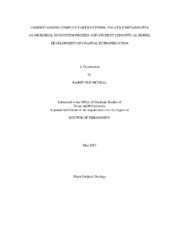| dc.contributor.advisor | Herbert, Bruce E. | |
| dc.creator | McNeal, Karen Sue | |
| dc.date.accessioned | 2010-01-14T23:58:38Z | |
| dc.date.accessioned | 2010-01-16T01:37:44Z | |
| dc.date.available | 2010-01-14T23:58:38Z | |
| dc.date.available | 2010-01-16T01:37:44Z | |
| dc.date.created | 2007-05 | |
| dc.date.issued | 2009-05-15 | |
| dc.identifier.uri | https://hdl.handle.net/1969.1/ETD-TAMU-1321 | |
| dc.description.abstract | Understanding complex Earth systems is challenging for scientists and students
alike, because of the characteristics (e.g. bifurcations, self-organization, chaotic
response) that are associated with these systems. This research integrates two research
strands which contribute to the scientific and pedagogical understanding of complex
Earth systems. In the first strand, a method that characterizes volatile organic
compounds (VOCs) as ecological proxies of soil microbial ecosystems was validated.
Unlike other measures of microbial community structure (e.g. Biolog and FAME),
VOCs are advantageous because they are non-destructive and can provide temporal and
spatial data. Additionally they are rich sources of information that describe the
microbial metabolism, community structure, and organic carbon substrates utilized by
soil microorganisms. Statistical results indicate that the detected and identified VOCs
were significant (p < 0.05) indicators of microbial community composition shift in soil microcosm studies. Geographical information systems (GIS) illustrates that VOCs
varied with space and time in south Texas soils.
The second strand focuses on a geoscience education study exploring student
conceptual model development of complex Earth systems. The efficacy of multiple
representations and inquiry was tested as the pedagogical strategy in upper and lower
level undergraduate courses to support students’ conceptual model development of
complex Earth systems. Comparisons in student performance were based on prior
knowledge (low and high) and on exposure to the implemented pedagogy (control and
experimental groups). Results indicate that an inquiry-based learning model coupled
with the use of multiple representations had significant positive performance impacts on
students’ conceptual model development and content knowledge.
This dissertation model integrates science and education research and is
particularly useful for graduate students who intend to pursue a career in academia and
envision teaching as part of their professional duties. It allows for synergy between
teaching and research to be achieved where the classroom becomes a laboratory for
research. Ultimately, the research conducted in the classroom informs pedagogy and
enhances scholarship. Graduates learn to bridge the gap between education and science
departments where they become leaders in science who conduct cutting-edge scientific
research and also value making a broader impact on society through enhancing public
education. | en |
| dc.format.medium | electronic | en |
| dc.format.mimetype | application/pdf | |
| dc.language.iso | en_US | |
| dc.subject | Volatile Organic Compounds | en |
| dc.subject | Biomarkers | en |
| dc.subject | Spatial and Temporal Dynamics | en |
| dc.subject | Microbial Community | en |
| dc.subject | Inquiry | en |
| dc.subject | Multiple Representations | en |
| dc.subject | Complex Earth Systems | en |
| dc.subject | Conceptual Model Development | en |
| dc.subject | Undergraduate Students | en |
| dc.title | Understanding complex Earth systems: volatile metabolites as microbial ecosystem proxies and student conceptual model development of coastal eutrophication | en |
| dc.type | Book | en |
| dc.type | Thesis | en |
| thesis.degree.department | Geology and Geophysics | en |
| thesis.degree.discipline | Geology | en |
| thesis.degree.grantor | Texas A&M University | en |
| thesis.degree.name | Doctor of Philosophy | en |
| thesis.degree.level | Doctoral | en |
| dc.contributor.committeeMember | Autenrieth, Robin | |
| dc.contributor.committeeMember | McGuire, Jennifer | |
| dc.contributor.committeeMember | Morse, John W. | |
| dc.contributor.committeeMember | Schielack, Janie | |
| dc.contributor.committeeMember | Stuessy, Carol | |
| dc.type.genre | Electronic Dissertation | en |
| dc.type.material | text | en |
| dc.format.digitalOrigin | born digital | en |


